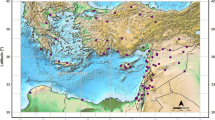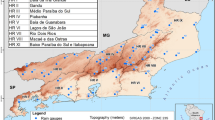Abstract
A method of moving precipitation totals is described and applied for the analysis of precipitation extremes in Estonia. Numbers of extremely wet and extremely dry days and other indices of precipitation extremes were calculated using the daily precipitation data measured at 51 stations over Estonia during 1957–2009. Mean regularities of spatial and seasonal distribution were determined. Long-term changes were detected using Sen's method and Mann–Kendall test. The highest risk of heavy precipitation is in the regions of higher mean precipitation on the uplands and on the belt of higher precipitation in the western part of continental Estonia. Wet spells have their sharp maxima in July and August. The highest risk of droughts is observed in the coastal regions of West Estonia. In the coastal area, droughts appear mostly in the first half of summer, while in the eastern Estonia, they are usually observed during the second half of summer. Extreme precipitation events have become more frequent and intense. Statistically significant increasing trends were, first of all, found in the time series of winter extreme precipitation indices. In summer and autumn, trends existed in some indices, but in spring, there were no trends at all. There were no trends in time series of dryness indices in Estonia in 1957–2009.
















Similar content being viewed by others
References
Achberger C, Chen D (2006) Trend of extreme precipitation in Sweden and Norway during 1964–2004. Research Report C72, Earth Science centre, Gothenburg University
Alexandersson H (2002) Temperature and precipitation in Sweden 1860–2001. SMHI Meteorologi, p 104
Alpert P, Ben-Gai T, Baharad A, Benjamini Y, Yekutieli D, Colacino M, Diodato L, Ramis C, Homar V, Romero R, Michaelides S, Manes A (2002) The paradoxical increase of Mediterranean extreme daily rainfall in spite of decrease in total values. Geophys Res Lett 29. doi:10.1029/2001GL013554
Avotniece Z, Rodinov V, Lizuma L, Briede A, Kļaviņš M (2010) Trends in the frequency of extreme climate events in Latvia. Baltica 23:135–148
BACC Author Team (2008) Assessment of climate change for the Baltic Sea basin. Springer, Berlin, p 473
Balling RC, Goodrich GB (2010) Increasing drought in the American Southwest? A continental perspective using a spatial analytical evaluation of recent trends. Phys Geogr 31:293–306
Byun HR, Wilhite DA (1999) Objective quantification of drought severity and duration. J Climate 12:2747–2756
Chen D, Walther A, Moberg A, Jones PD, Jacobeit J, Lister D (2006) Trends of extreme temperature and precipitation climates in Europe - a trend atlas of the EMULATE indices. Research Report C73, Earth Science centre, Gothenburg University
Dai A, Trenberth KE, Qian T (2004) A global data set of Palmer Drought Severity Index for 1870–2002: relationship with soil moisture and effects of surface warming. J Hydrometeorol 5:1117–1130
Førland EJ (2000) Trends in precipitation intensity in Norway and the Nordic region during the 20th century. ECAC2000: 3rd European Conference on Applied Climatology, 16–20 October 2000, Pisa, Italy. ISBN 88-900502-0-9
Frei C, Schär C (2001) Detection probability of trends in rare events: theory and application to heavy precipitation in the Alpine region. J Climate 14:1568–1584
Frich P, Alexander LV, Della-Marta P, Gleason B, Haylock M, Klein Tank AMG, Peterson T (2002) Observed coherent changes in climatic extremes during the second half of the twentieth century. Clim Res 19:193–212
Groisman PY, Koknaeva VV, Belokrylova TA, Karl TR (1991) Overcoming biases of precipitation measurements: a history of the USSR experience. Bull Amer Meteorol Soc 72:1725–1733
Groisman PY, Knight RW, Easterling DR, Karl TR, Hegerl GC, Razuvaev VN (2005) Trends in intense precipitation in the climate record. J Climate 18:1326–1350
Groisman PY, Sherstyukov BG, Razuvaev VN, Knight RW, Enloe JG, Stroumentova NS, Whitfield PH, Førland E, Hannsen-Bauer I, Tuomenvirta H, Alexandersson H, Mescherskaya AV, Karl TR (2007) Potential forest fire danger over Northern Eurasia: changes during the 20th century. Global Planet Chang 56:371–386
Haylock MR, Goodess CM (2004) Interannual variability of European extreme winter rainfall and links with large-scale circulation. Int J Climatol 24:759–776
Heino R (1994) Climate in Finland during the period of meteorological observations. Finnish Meteorological Institute, Contributions 12
Heino R, Brázdil R, Førland EJ, Tuomenvirta H, Alexandersson H, Beninston M, Pfister C, Rebetez M, Rosenhagen G, Rösner S, Wibig J (1999) Progress in study of climatic extremes in northern and central Europe. Climate Change 42:151–181
Jaagus J (1992) Periodicity of precipitation in Estonia. Estonia. In: Kaare T, Mardiste H, Punning JM (eds) Estonia. Man and nature. Estonian Geographical Society, Tallinn, pp 43–53
Jaagus J (1996) Climatic trends in Estonia during the period of instrumental observations and climate change scenarios. Estonia in the system of the global climate change. Institute of Ecology. Publication, 4:35–48
Jaagus J (2006) Climatic changes in Estonia during the second half of the 20th century in relationship with changes in large-scale atmospheric circulation. Theor Appl Climatol 83:77–88
Jaagus J, Tarand A (1988) Territorial distribution of precipitation in Estonia. Yearb Estonian Geogr Soc 24:5–16, in Estonian, summary in English
Jaagus J, Briede A, Rimkus E, Remm K (2010) Precipitation pattern in the Baltic countries under the influence of large-scale atmospheric circulation and local landscape factors. Int J Climatol 30:705–720
Karl RT, Knight RW (1998) Secular trends of precipitation amount, frequency, and intensity in the USA. Bull Am Meteorol Soc 79:231–241
Keevallik S (2003) Changes in spring weather conditions and atmospheric circulation in Estonia (1955–95). Int J Climatol 23:263–270
Keevallik S, Post P, Tuulik J (1999) European circulation patterns and meteorological situation in Estonia. Theor Appl Climatol 63:117–127
Kiktev D, Sexton DMH, Alexander L, Folland C (2003) Comparison of modelled and observed trends in indices of daily climate extremes. J Climate 16:3560–3571
Kim D-W, Byun HR (2009) Future pattern of Asian drought under global warming scenario. Theor Appl Climatol 98:137–150
Kivi K (1998) Dangerous weather phenomena. Estonian Meteorological and Hydrological Institute, Tallinn, in Estonian
Klein Tank AMG, Können GP (2003) Trends in indices of daily temperature and precipitation extremes in Europe 1946–99. J Climate 16:3665–3680
Łupikasza E (2010) Spatial and temporal variability of extreme precipitation in Poland in the period 1951–2006. Int J Climatol 30:991–1007
Mätlik O, Post P (2008) Synoptic weather types that have caused heavy precipitation in Estonia in the period 1961–2005. Estonian J Eng 14:195–208
Merilain M, Post P (2006) Heavy rainfall—is it only a feature of recent years' summers in Estonia? Publ Geophys Univ Tartuensis 50:144–153, in Estonian, summary in English
Moberg A, Jones PD (2005) Trends in indices for extremes in daily temperature and precipitation in central and western Europe, 1901–99. Int J Climatol 25:1149–1171
Osborn TJ, Hulme M, Jones PD, Basnett TA (2000) Observed trends in the daily intensity of United Kingdom precipitation. Int J Climatol 20:347–364
Päädam K, Post P (2011) Temporal variability of precipitation extremes in Estonia 1961–2008. Oceanologia 53:245–257
Remm K, Jaagus J, Briede A, Rimkus E, Kelviste T (2011) Interpolative mapping of mean precipitation in the Baltic countries using landscape characteristics. Est J Earth Sci 60:172–190
Rimkus E, Kažys J, Bukantis A, Krotovas A (2011) Temporal variation of extreme precipitation events in Lithuania. Oceanologia 53:259–277
Salmi T, Määttä A, Anttila P, Ruoho-Airola T, Amnell T (2002) Detecting trends of annual values of atmospheric pollutants by the Mann-Kendall test and Sen's slope estimates—the Excel template application MAKESENS. Finnish Meteorol Inst Rep 31
Scaife AA, Folland CK, Alexander LV, Moberg A, Knight JR (2008) European climate extremes and the North Atlantic Oscillation. J Climate 21:72–83
Schmidli J, Frei C (2005) Trends of heavy precipitation and wet and dry spells in Switzerland during the 20th century. Int J Climatol 25:753–771
Sen Roy S, Balling RC (2004) Trends in extreme daily rainfall indices in India. Int J Climatol 24:457–466
Stone DA, Weaver AJ, Zwiers FW (2000) Trends in Canadian precipitation intensity. Atmos Ocean 38:321–347
Tammets T (2007) Distribution of extreme wet and dry days in Estonia in last 50 years. Proc Estonian Acad Sci Eng 13:252–259
Tammets T (2010) Estimation of extreme wet and dry days through moving totals in precipitation time series and some possibilities for their consideration in agrometeorological studies. Agron Res 8:433–438
Valiukas D (2011) Dry periods in 1891–2010 in Vilnius. Geography 47(1):9–18, in Lithuanian, summary in English
Wibig J (2009) Variability of daily precipitation totals in Poland (1951–2000). Geogr Pol 82:21–32
Zhang X, Hogg WD, Mekis E (2001) Spatial and temporal characteristics of heavy precipitation events in Canada. J Climate 14:1923–1936
Zolina OG (2011) Changes in the duration of synoptic rainy periods in Europe from 1950 to 2008 and their relation to extreme precipitation. Dokl Earth Sci 436:690–695
Zolina O, Simmer C, Kapala A, Bachner S, Gulev S, Maechel H (2008) Seasonally dependent changes of precipitation extremes over Germany since 1950 from a very dense observational network. J Geophys Res 113(D06110). doi:10.1029/2007JD008393
Zolina O, Simmer C, Belyaev K, Kapala A, Gulev S (2009) Improving estimates of heavy and extreme precipitation using daily records from European rain gauges. J Hydrometeorol 10:701–716
Zolina O, Simmer C, Gulev S, Kollet S (2010) Changing structure of European precipitation: longer wet periods leading to more abundant rainfalls. Geophys Res Lett 37(L06704). doi:10.1029/2010GL042468
Zou XK, Zhai PM, Zhang Q (2005) Variations in droughts over China: 1951–2003. Geophys Res Lett 32(L04707). doi:10.1029/2004GL021853
Acknowledgments
This study has been supported by the grant no. 7510 of the Estonian Science Foundation and by the target financed project SF0180049s09 of the Ministry of Education and Science of the Republic of Estonia. The authors thank their colleagues Raivo Aunap and Andres Luhamaa for the assistance in preparing the cartographic images.
Author information
Authors and Affiliations
Corresponding author
Rights and permissions
About this article
Cite this article
Tammets, T., Jaagus, J. Climatology of precipitation extremes in Estonia using the method of moving precipitation totals. Theor Appl Climatol 111, 623–639 (2013). https://doi.org/10.1007/s00704-012-0691-1
Received:
Accepted:
Published:
Issue Date:
DOI: https://doi.org/10.1007/s00704-012-0691-1




